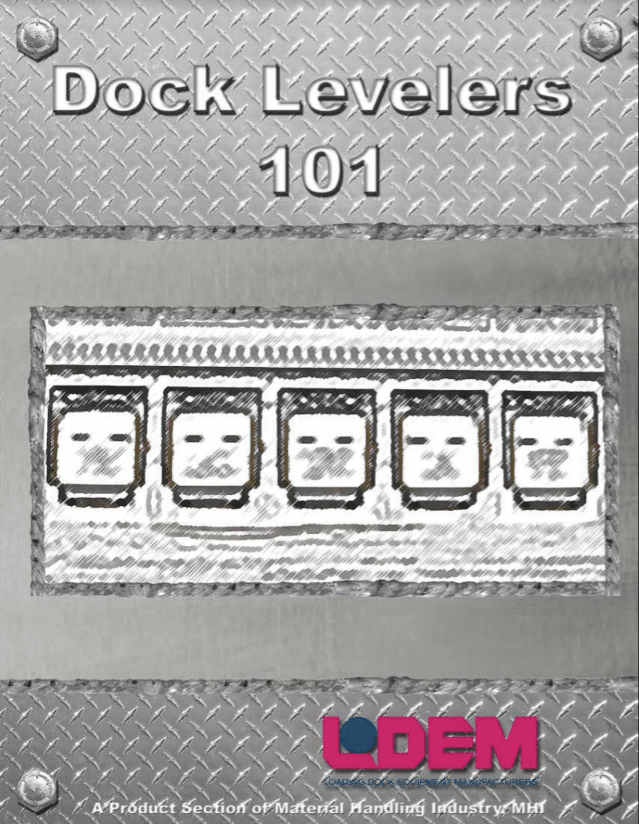Do you have questions about dock levelers? If you do, but didn’t know where (or whom) to ask, this blog is for you. This is Dock Levelers 101. Here are some common questions and answers about what they are and how dock levelers function.

What Are Dock Levelers?
Dock levelers are pieces of equipment usually mounted either to the face of the loading dock or recessed into a pit at the dock door. They allow workers to maneuver industrial vehicles like forklifts between the building and a transport vehicle in order to transport products from trucks to building.
Are There Different Kinds of Dock Levelers?
Yes, manufacturers produce many different kinds. Here are some common types of dock levelers:
Pit Levelers – Pit levelers are the type found in a recessed concrete openings at the dock door.
The most common type of pit leveler is the Mechanical Pit Leveler. This type of leveler uses a mechanical spring system to raise the leveler. Typically mechanical levelers are “upward biased,” meaning the leveler’s spring forces the leveler deck to rise up. A restraining device prevents that motion when the leveler is not in use. This type of leveler does not require electricity and is the least expensive to purchase but tends to be the most expensive to service and to maintain over time.
A second type of pit leveler is the Air Pit Leveler. This type of leveler uses a pneumatic bag system to raise and lower the leveler deck. Air pit levelers need an electrical power source either at the dock or adjacent to it, and typically this power source would be standard 110V. Air pit levelers tend to be more expensive than mechanical levelers, but they also tend to need less service and maintenance over a lifetime of use compared to mechanical units.
A third type of pit leveler is the Hydraulic Pit Leveler. In this type of leveler a hydraulic cylinder raises and lowers the deck, while another is typically used to operate the lip. Hydraulic levelers may come in various configurations and may be powered by everything from 110V single phase to 575V three-phase. More versatile than either mechanical or air dock levelers and more expensive, hydraulic levelers typically have lower service and maintenance costs.
In addition to pit levelers, there are other types, including the:
Vertical Leveler – This is a dock leveler that is stored in a vertical position which is desirable because it allows for storage inside the building. You can close your dock door on concrete with a vertical leveler instead of across the leveler, as with pit levelers. This can allow for better control over the environmental in your building. Vertical levelers are most commonly used in food service applications or areas where wash down is necessary. This type of leveler is typically pit or shelf-mounted and hydraulically operated.
Rail Dock Leveler – Rail dock levelers involve a variation on the vertical leveler. They are used to service rail cars and are typically mounted on a sliding rail that allows them to move horizontally along the rail track. Rail dock levelers can be moved along the track either manually or hydraulically and are typically hydraulically operated.
Edge of Dock Leveler – The Edge of Dock (or EOD) leveler is a simple device that is usually mechanically operated but may be pneumatically or hydraulically operated. It may be pit mounted, but it’s more often mounted on the exterior wall of a building with an integral bumper set. The EOD has a limited vertical operating range and is geared toward applications where the transport vehicle bed is at, or very near, the floor level of the building (dock level). Generally inexpensive when compared to a pit or vertical dock leveler, the edge of dock levelers may be considered an upgrade from portable dock boards because they are fixed to the dock face and have some form of lift assistance (mechanical, air or hydraulic). Typically the recommended normal working range of an EOD is +/- 3 inches.
Top of Dock Leveler – The Top of Dock (or TOD) leveler is a version of an EOD leveler. It’s usually mounted to the floor surface and the leading edge of the dock face of the building. A TOD leveler doesn’t usually require concrete work. The working range of these units is intended to provide primarily above-dock working range.
If you have other questions about dock levelers besides what is covered in this Dock Levelers 101, please call us at Beuschel Sales at (616) 520-8680. We will be happy to talk with you about your loading dock and your company’s specific needs.
